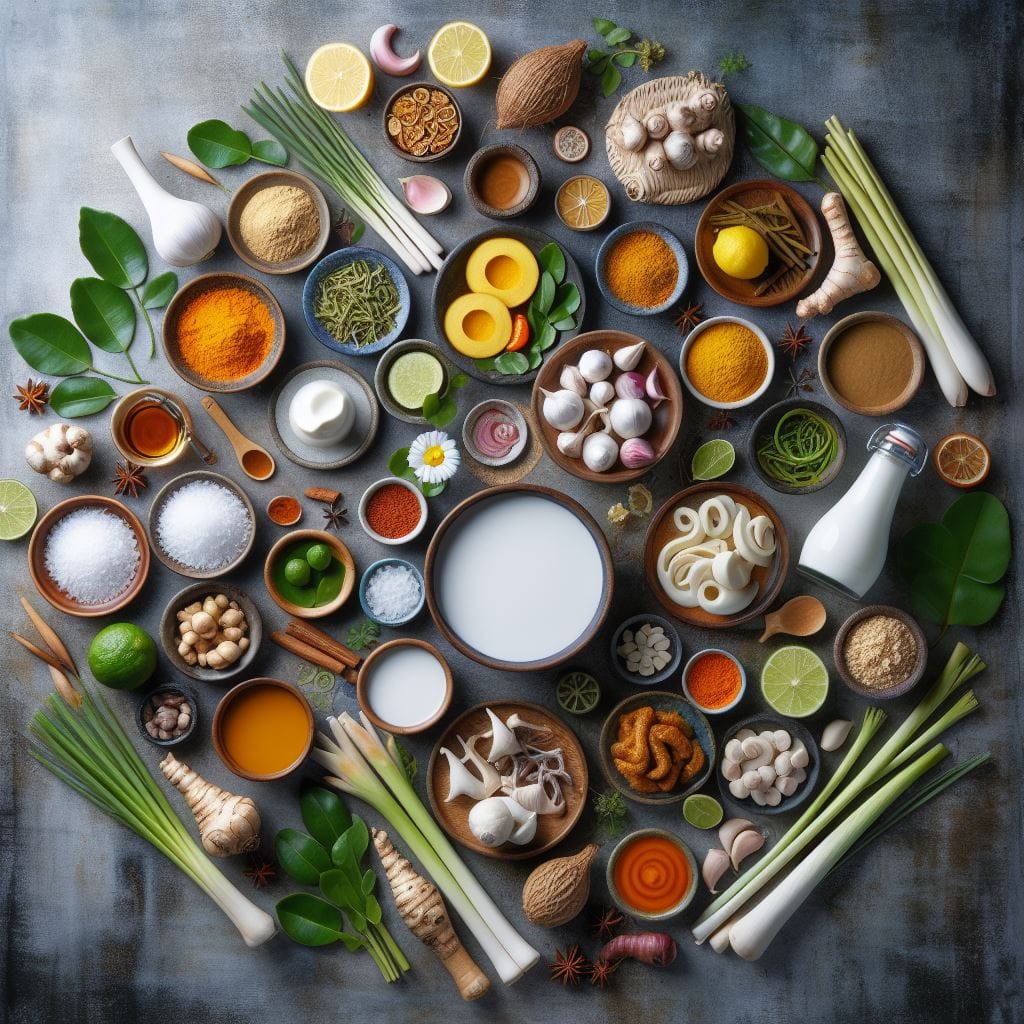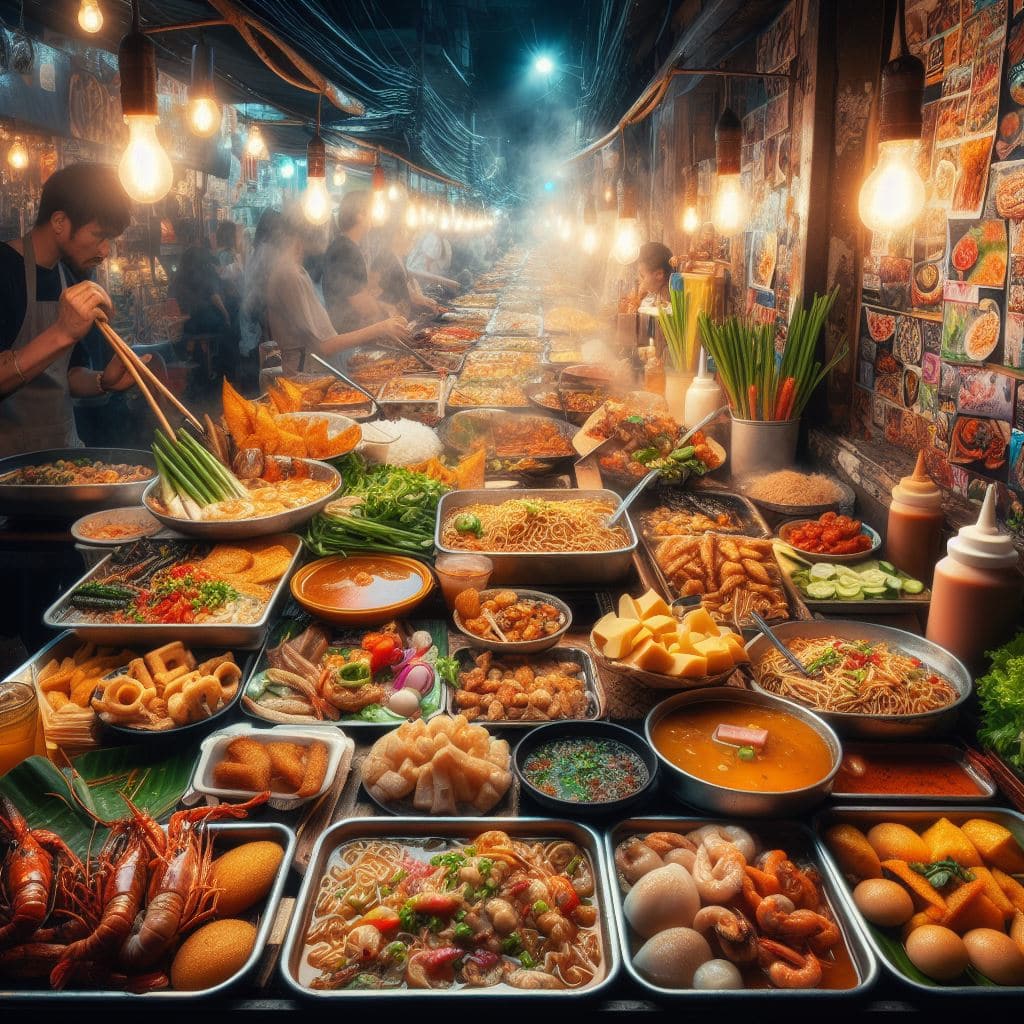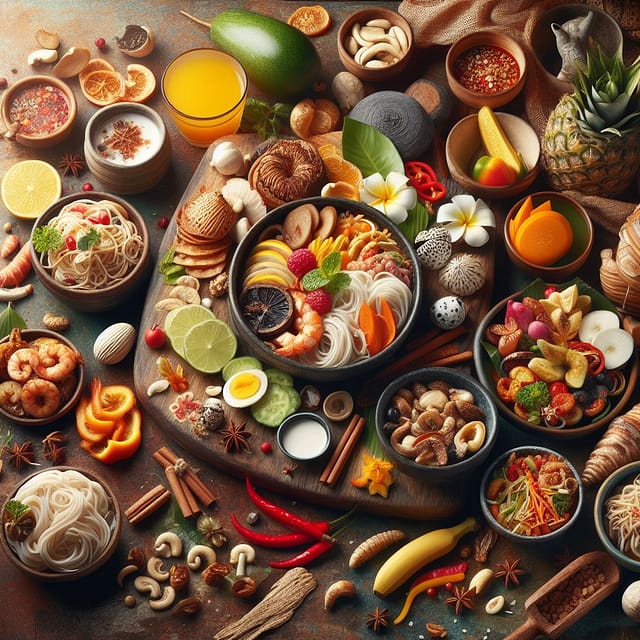The Kingdom of Thailand, a nation blessed with lush jungles, pristine beaches, and a vibrant cultural mosaic, beckons not only the intrepid explorer yearning for adventure but also the epicurean seeker driven by a deep hunger for the rich tapestry of flavors that define its culinary heritage. Known for an intricate balance of the five basic tastes-sweet, imparted by the natural sugars of palm and coconut; hot, from the fiery chiles that dance on the tongue; sour, from the tang of tamarind and lime; bitter, provided by various greens and herbs; and salty, a taste deepened by the umami of fish sauce-Thai cuisine is a testament to the country’s ability to harmonize diverse flavor profiles.
Each Thai dish is a symphony of flavors that entices and satisfies gourmands around the world, taking them on a delicious journey through its vast repertoire of dishes. Our foray into the seductive realm of Thai cuisine will reveal the vast array of flavors, the essential ingredients that form its foundation, and the rich traditions woven into its culinary practices that give it a character as distinct as it is beguiling.

Unearthing the historical origins of traditional Thai cuisine
The history of Thai cuisine is as complex and nuanced as its flavors. Influenced by the cooking styles of its neighbors, especially China, India, and Myanmar, Thai food also reflects the indigenous ingredients and practices of the various regions within Thailand. From the fiery curries of the south to the mild, brothy soups of the north, Thai cuisine encompasses a diverse range of dishes.
Discover the essential ingredients that define Thai food
Freshness is key in Thai cooking, with an emphasis on herbs, spices, and aromatic roots that add depth to each dish. Lemongrass, galangal, kaffir lime leaves, Thai basil, and coriander are just a few of the staples that give Thai cuisine its distinctive flavor. Proteins such as chicken, pork, beef, and a variety of seafood reflect the country’s agrarian roots and bountiful coastline. Soy sauce, fish sauce, and shrimp paste are essential condiments used to season and add the typical salty flavor.
Famous dishes of Thai gastronomy that you must try
Any discussion of Thai food would be incomplete without mentioning Pad Thai, the world-famous stir-fried noodle dish. But Thai cuisine goes far beyond this popular dish. Gaeng Keow Wan (Green Curry) and Tom Yum Goong (Spicy Shrimp Soup) are renowned for their complex, layered flavors. Som Tum (Papaya Salad) represents the northeastern region’s love of fiery, tangy salads, while Khao Soi (Coconut Curry Noodle Soup) showcases the northern Thai preference for creamy curries and noodles.

Street Food: The Heartbeat of Thai Cuisine
As you wander the vibrant streets of Thailand, the air is perfumed with an enticing symphony of aromas that lead you to the heart of the nation’s culinary spirit: its street food scene. Buzzing with the hustle and bustle of locals and travelers alike, the sidewalks teem with vendors artfully crafting an eclectic array of delicacies. From the sizzling sounds of meats cooked to perfection over open flames, such as moo ping – the much revered Thai-style barbecued pork skewers – to the visually striking arrangements of freshly sliced tropical fruits, each street stall beckons with its own gastronomic allure.
Thailand’s version of fast food is a delightful feast for the senses. Here, traditional recipes passed down through generations are the foundation of an illustrious food culture, passionately preserved by the tireless hands of street food masters. As day turns to night, the streets turn into a culinary carnival where you can savor the exquisite combination of flavors that Thai cuisine expertly balances. Amidst this cornucopia of street food is mango sticky rice, a dessert that epitomizes simple elegance – glutinous rice steamed to perfect chewiness, then paired with ripe, sweet mangoes, often then glazed with a generous drizzle of coconut cream and sprinkled with roasted mung beans or sesame seeds.
Each bite offers a harmonious dance between the creamy, the sweet, and the subtle crunch, a humble yet iconic representation of Thai culinary genius. While Thai cuisine revels in the complex layers of flavors and textures, its street food retains an approachable and joyful nature, inviting everyone to participate in this rich and interactive dining experience.
Master the art of Thai cuisine: A Journey into Thailand’s Flavorful Traditions
The intricate dance of blending flavors in Thai cooking is a testament to its dual nature as both a meticulous science and a form of creative expression. The act of orchestrating the symphony of flavors for which Thai cuisine is celebrated involves the precise combination of ingredients in well-judged proportions, a skill that requires a nuanced understanding of each element’s impact on the overall taste. This expertise is not acquired overnight; it is honed through years of practice and dedication, as chefs and avid home cooks embark on a lifelong journey of culinary discovery and perfection.
At the heart of this culinary art lies the iconic Thai mortar and pestle, an essential tool that symbolizes the country’s food preparation traditions. Unlike modern kitchen appliances, the mortar and pestle provides a tactile intimacy with ingredients, allowing for the creation of pastes and salads infused with a rich tapestry of flavors. With each rhythmic pounding and grinding, the essential oils and unique essences of herbs and spices are delicately coaxed out, layering each dish with a complexity that is simply unattainable by any other means.
This process is not just about pulverizing ingredients; it is about blending them into flavorful pastes that serve as the foundation for countless Thai dishes. From the fiery curry pastes redolent with spice and heat to the more subtle but equally aromatic mixes found in salads and dips, the centuries-old method of mortar and pestle is a testament to techniques passed down through generations. These methods, steeped in heritage and cultural identity, are a vital component in ensuring the future of Thai cuisine, ensuring that each new dish pays homage to the authenticity of the nation’s gastronomic history.
Taste the essence of Thailand: A culinary journey through Thai cuisine
To experience the rich tapestry of Thai cuisine, one must immerse oneself not only in the flavors, but also in the local dining traditions that embody the community spirit of Thailand. Utensils play a unique role in this culinary experience; while Western dining often emphasizes the use of a knife, in Thailand it is customary to eat with a fork and spoon. The fork acts as an assistant, gently guiding bites of food to the spoon, which is the primary vehicle for delivering the harmonious blend of sweet, sour, spicy and savory to the mouth. In contrast to many Western practices, soup in Thai cuisine is not relegated to a separate course, but is enjoyed at the same time as the main dishes, allowing diners to appreciate the interplay of flavors between sips of broth and bites of food.
In addition, Thai meals are inherently convivial affairs, with shared dishes placed in the center of the table, inviting everyone to participate. This communal approach to dining reflects a core tenet of Thai culture, where food is seen as a unifying force that fosters connection and community. The act of sharing not only enriches the dining experience, but also embodies the generous spirit of Thai hospitality, making each meal a participatory and socially engaging event. When indulging in Thai cuisine, embracing these customs can lead to a more authentic and culturally enriching dining experience that goes beyond the palate and touches the heart of Thailand’s vibrant culinary heritage.
Inclusion of vegetarian and vegan options in Thai cuisine
In the vibrant landscape of international cuisine, both Thai and Mexican gastronomy stand out for their rich flavors and colorful presentations. As the world becomes increasingly health conscious with an emphasis on plant-based diets, Thai cuisine demonstrates its versatility by elegantly adapting to these dietary preferences. It seamlessly transitions to accommodate vegetarians and vegans by replacing traditional meat ingredients with hearty alternatives such as tofu. This plant-based protein is cleverly integrated into classic dishes, allowing vegans and vegetarians to enjoy the essence of Thai flavors. In addition, the cornucopia of fresh vegetables available in Thailand’s markets allows for an endless variety of dishes, ensuring that a plant-based diet is anything but monotonous.
Unlike the warm, earthy spices and hearty beans and corn that characterize Mexican cuisine, an array of inherently vegetarian Thai dishes are ready to delight the palate. Pad pak, a simple yet satisfying stir-fried vegetable dish, celebrates the natural flavors and textures of Thai produce, while the country’s varied salads, often dressed with tangy lime juice and aromatic herbs, offer a refreshing meal option. Curries, rich with coconut milk and infused with lemongrass, galangal, and kaffir lime leaves, demonstrate that you don’t have to rely on animal-based ingredients to enjoy the deep, complex flavors that Thai cuisine is known for.
Just as Mexican cuisine can be found in plant-based forms around the globe, from bean-filled burritos to vegetable-stuffed tacos, Thai cuisine is a testament to the adaptability and global reach of plant-based diets. From the streets of Bangkok to the kitchens of the world, Thai dishes continue to evolve, inspiring food lovers and chefs alike to explore the confluence of health, sustainability, and taste that defines today’s culinary movements. Whether nestled alongside the bold flavors of Mexican cuisine or enjoyed on its own, the future of Thai plant-based cuisine looks bright, flavorful, and full of the same zest and zeal that has made it a beloved choice for food lovers everywhere.

Tracing the global journey of Thai cuisine from the heart of Thailand to international fame
The global diaspora of Thai people have acted as culinary ambassadors for the rich gastronomic traditions of their homeland. As they have migrated and settled in different parts of the world, they have carried with them the cherished flavors of their heritage, creating a tapestry of Thai eateries that spans continents.
From bustling city centers to quiet suburban streets, the versatility of Thai cuisine is celebrated in a variety of settings: from the vibrant Thai restaurants that serve as community hubs to the aromatic food carts that dot street corners, enticing passersby with the promise of an authentic taste of Thailand. This culinary migration has not only introduced Thai cuisine to an international audience, but also demonstrated its remarkable adaptability.
Thai chefs overseas have become adept at incorporating local ingredients into traditional recipes, creating innovative dishes that remain true to the core principles of Thai cuisine while embracing the produce and palates of their adopted regions. This cross-pollination of flavors and textures has not only enriched the global food scene but has also ensured that Thai cuisine continues to evolve and thrive, reflecting a beautiful balance between its storied past and dynamic future. In doing so, it has secured its position not only as a staple of global cuisine but as an ever-evolving art form that invites culinary connoisseurs and casual diners alike to discover and rediscover the wonders of Thai cuisine.

The Future of Thai Cuisine – An Insight into the Evolution and Influence of Thailand’s Culinary Wonders
In today’s ever-changing culinary landscape, marked by rapid changes in food trends and increased awareness of dietary preferences and health concerns, Thai cuisine remains resilient and continues to captivate and thrive on the global stage. Respected chefs, both in the vibrant street markets of Thailand and in the bustling kitchens of international dining establishments, fearlessly innovate, blending new ingredients and avant-garde cooking techniques with the revered, time-honored culinary practices of the Thai people.
This delicate dance between the contemporary and the traditional has fueled an exciting evolution of Thai cuisine, breathing new life into classic dishes without abandoning the rich heritage that has cemented Thai food as an exquisite gastronomic delight revered across continents. As Thai cuisine undergoes this metamorphosis, it not only preserves the essence of its storied past, but also secures its place in the future of global culinary arts, remaining a treasured jewel for epicureans worldwide.
Conclusion
On a journey to the heart of Southeast Asia, Thai cuisine emerges as not only a vibrant embodiment of Thailand’s rich history and diverse culture, but also a testament to the ingenious spirit of its people. From iconic dishes that have achieved international fame, such as pad thai and green curry, to the lesser known but equally captivating regional specialties that remain hidden treasures of Thailand’s provinces, Thai cuisine offers a culinary map for gourmands eager to traverse its flavors. The aromatic complexity and harmonious balance of sweet, sour, spicy and salty flavors are a clarion call to food lovers worldwide, inviting them to travel to Thailand through their taste buds.
As we embark on this flavorful journey, riding the wave of each spicy street food encounter and immersing ourselves in the crafted elegance of a gourmet meal in the sanctum of a fine dining restaurant, it is the inimitable essence of Thailand that leaves an indelible mark on our senses. We hope that your culinary adventure into the aromatic kitchens and bustling markets of this exquisite country will deepen your appreciation for a cuisine that spans centuries of tradition and innovation. With each visit or virtual experience, you may be inspired to recreate the vibrancy of Thai dishes in your own kitchen or plan your next trip to experience the authenticity of Thai flavors in their native environment.
Thai cuisine is more than nourishment; it is an immersive experience that encompasses the warmth of its people, the generosity of its community, and the bounty of its land. We wholeheartedly invite you to participate in this ongoing gastronomic celebration. As you embrace the exciting world of Thai cuisine – a world where every plate is steeped in storytelling, every bite resonates with history, and every morsel beckons you to embark on a culinary odyssey – it becomes clear that a journey to explore Thai culinary artistry is an exploration of life itself, filled with the zest, zeal, and vibrant spirit of Thailand.




